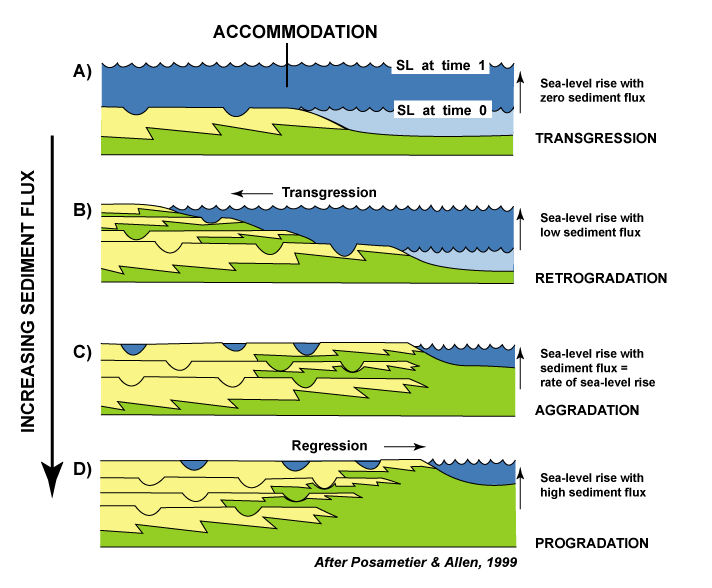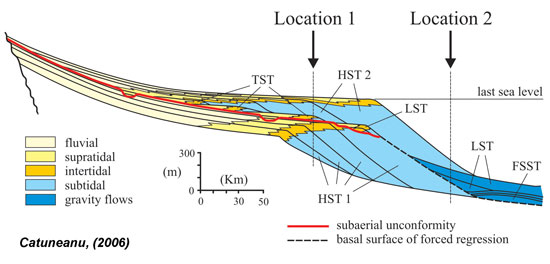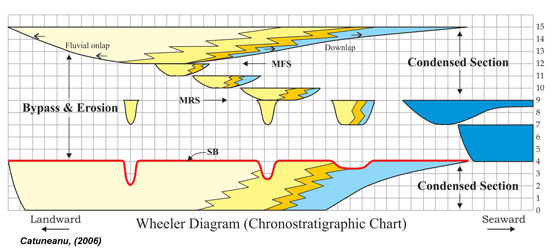|
offlap
onlap
terminations



|
This term is sometimes used by seismic interpreters for reflection patterns generated by strata representing a regressive progradational shoreline. This characteristic geometry is commonly refered to a prograding coast. This progradiation may be normal or the result of a forced regression. The offlapping or progradinpattern will have different coastal trajectories depending on the changing position of the sea during the process of off lapping (Steel et al, 1985)!

The section on coastal trajectory explains that the shoreline may lie at the margin of a basin that deepens offshore so it tracks the response of sedimentary fill to the movement of relative sea level. If the facies of this shore are clastic then these will range from barrier islands to deltaic sediment bodies while if the setting is a carbonate factory the shoreline may include carbonate barrier islands to reefs.
In terms of coastal trajectory during a sea level fall of the Falling (or Early) Lowstand System Tract (FSST) the shoreline trajectory will be expected to fall offshore during a forced regression; then it may either aggrade or onlap landward, rising above the underlying sedimentary fill during the following Lowstand (or Late Lowstand) System Tract (LST). If the margin or basin floor are shallow enough, the shoreline trajectory will often build out at an initially shallow angle but as the sea level rise outstrips sediment supply the shoreline will retreat, climbing back over the underlying sedimentary fill. During the following transgression, a Transgressive System Tract forms and the shoreline will often be retrogradatonal in character, climbing and building back over the underlying sedimentary fill. During the following relative sea level highstand, if the basin margin is shallow enough then the trajectory of the shoreline will tend to prograde out at a low angle. Should the basin deepen rapidly then the trajectories of the shoreline will tend to steepen, being unable to fill the basin and build out over it.
Below is are two diagrams from Chapter 7 of Catuneanu's (2006) text that capture the varying trajectory of the offlapping and/or prograding coast. Note how the trajectories of the offlapping coastal sand bodies track the changing accomodation space, varying from higher angle trajectories when the accomodation increases more rapidly and sedimentation lags behind this, to lower angle trajectories when accomodation increase more slowly and sedimentation drives the coast out at a lower angle.
 
An offlap break will likely occur at the shelf break or may even be considered by some to be the shoreline ?
References
Catuneanu, Octavian (2006), "Principles of sequence stratigraphy", Elsevier, pp 375.
Steel, R., Gjelberg, J., Helland-Hansen, W., Kleinspehn, K., Nottved, A., & Rye-Larsen, M., 1985, The Tertiary strike-slip basins and orogenic belt of Spitsbergen; Biddle, Kevin T. (editor) Christie-Blick, Nicholas (editor), Strike-slip deformation, basin formation, and sedimentation, Special Publication - Society of Economic Paleontologists and Mineralogists, 37, p. 339-359, illus. incl. sects., sketch maps, 40 refs.
|